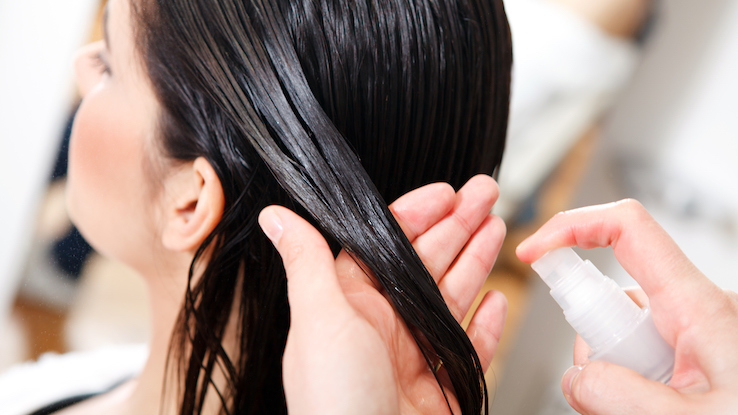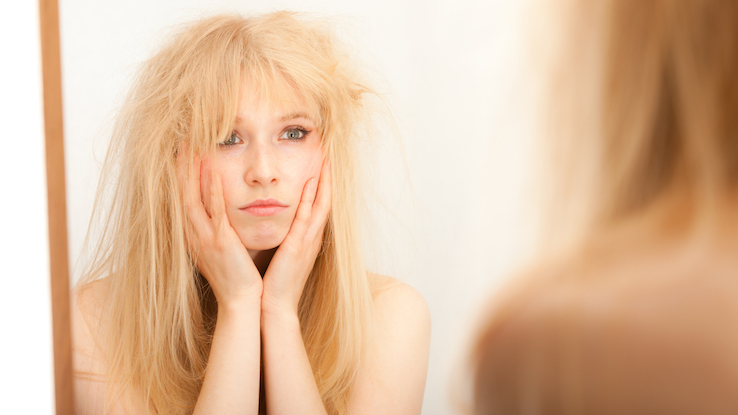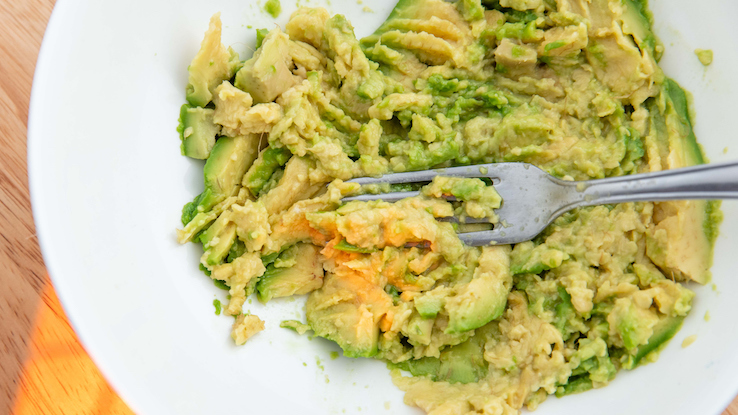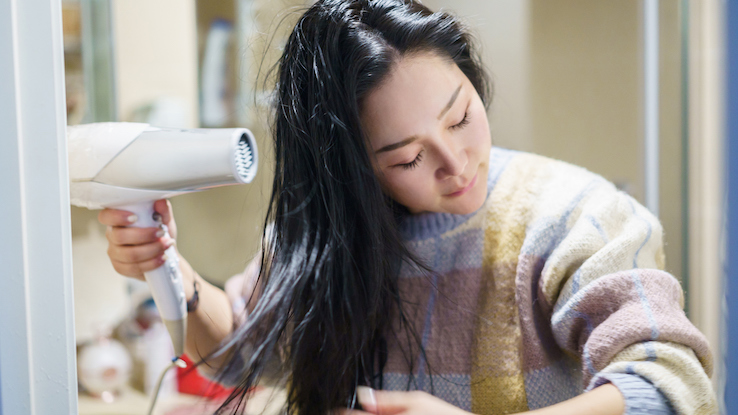
Is your hair feeling dry, brittle or damaged after coloring and chemical treatments or heat styling? Is it looking dull or frizzy even when you avoid washing it too frequently? No matter how your hair lost its moisture or became damaged, you can restore some of its natural shine and get your locks feeling smoother and healthier again. Trying easy at-home remedies — many of which involve simple, natural ingredients — can help you transform dry, damaged hair into sleek, manageable tresses.
What Leads to Damaged Hair?
To understand how hair becomes damaged, it helps to first understand the structure of your hair. Your hair shaft — the section of your hair that extends out and above the surface of your skin — and the individual strands are long chains of proteins bundled together to create fiber-like structures. These proteins are arranged in different ways in several layers to create a structure that ultimately makes your hair as a whole look, feel and behave the way it does.

There are three separate layers of cells, each of which is arranged differently, that make up every strand. At the center is the medulla, which is the fragile, soft core; scientists aren’t exactly sure what purpose it serves in hair’s structure, but they do know that this layer is often only present in very thick strands. Covering the medulla is the cortex, which is made of rod-like protein cells that contain melanin — the pigment that gives hair its color. The outermost layer is called the cuticle. It’s made up of thin, flat, overlapping cells that resemble shingles on a roof.
The cuticle’s main purpose is to protect the inner layers from becoming damaged. However, the cuticle itself can become damaged, which compromises your hair’s structural integrity and leads to the textural changes you may find difficult to manage. When the cuticle is damaged, the overlapping cells separate from one another, creating tiny “cracks” that lead to loss of moisture and make it easier for the cortex to lose nutrients. That’s why damage treatments often focus on smoothing the cuticle back down so it can retain its protective quality. Lifestyle habits, environmental conditions and the way you take care of your hair at home can all lead to damage like breakage and split ends.
Healthier Hair Starts in the…Kitchen?
Growing healthier hair starts with what you put in your body, and repairing damaged hair can start with what you put on your body — most of which you’ll find in your own kitchen. You likely have these treatment ingredients in your kitchen already, and if not, a quick trip to the grocery store is all you’ll need to get started.

Keep in mind that the scientific community doesn’t have an extensive body of research regarding how well the following treatments can affect the structure of your hair when applied topically. Despite this, the ingredients are generally healthful (and aren’t likely to harm you unless you’re allergic), so they’re worth trying to see what results they achieve.
Avocado Mask: Remove the skin and pit from a whole avocado and place the fruit’s flesh into a bowl. Add one whole raw egg and mash the two ingredients together. Apply this blend to the lengths of your hair while it’s wet, avoiding the roots to keep them from looking oily. Leave the avocado mixture on for about 20 minutes and rinse it out with cool water to keep the egg from “cooking.”
Using this mask once a week can restore softness and shine to your hair thanks to the avocado’s natural oils, vitamins and minerals (like copper and vitamins A, D, B and E) and the raw egg’s protein, which may strengthen the hair shaft by replenishing protein that’s lost during heat styling. The fats in the yolk may also help smooth the cuticle.
Vinegar Rinse: If your hair damage is leading to breakage, apple cider vinegar may be an effective remedy for limiting split ends and brittleness — and it couldn’t be easier to use. Mix one part apple cider vinegar and two parts water in a spray bottle. When you’re in the shower, wash your hair normally, and then saturate your hair with the diluted vinegar. Leave it on for about five minutes and rinse with cool water before conditioning your hair. If you’re sensitive to the smell, dilute the mixture with a few drops of your favorite essential oil.
One of the reasons why apple cider vinegar may be effective in reducing damage is because of its pH. The pH scale measures how acidic or alkaline (non-acidic) something is. When hair is more alkaline, friction between its fibers increases, and this leads to cuticle damage and breakage. Vinegar is acidic, and applying it to your hair can make your hair itself more acidic — lowering the alkalinity and thus any potential cuticle damage.
Banana Mask: Peel one or two ripe bananas, depending on the length of your hair, and mash them in a bowl using a fork. For an added protein boost, stir in one raw egg. Continue stirring until the ingredients are evenly blended and no lumps remain. Apply this mixture to your hair, taking extra care to ensure you coat split ends and damaged areas evenly. Leave the mask on for 10 minutes and rinse it out with cool water.
What makes bananas effective at smoothing and strengthening hair? It’s potentially their silica content. In several studies this mineral was found to prevent loss of strength, improve the structure of hair fibers and lessen breakage.
Change Your Habits to Change Your Hair Health
Using these helpful at-home treatments is a great way to jump-start your journey to less-damaged locks. However, taking some extra steps to change your habits can preserve the progress you see from your treatments and help you prevent more extensive damage to your hair in the future. These hair health-focused habits also make excellent home remedies, and most involve making just a few easy shifts in how you care for your hair.

How you wash your hair and what you use to wash it can impact the amount of damage your locks sustain. When you’re first noticing dryness and damage, you can start by washing your hair less frequently to see if that makes a difference. Some shampoos also strip your hair of its natural oils in the process of getting it clean. If the hair cleansers you use contain sulfates, look for sulfate-free versions. Sulfates are detergents and surfactants (meaning they help disperse dirt and oil, including your hair’s moisturizing natural oils) that can make your hair brittle and dry. Opt for hydrating shampoos and conditioners formulated for dry hair whenever possible.
Styling also plays a role in hair health. Using heated styling tools frequently can dry out your hair and lead to breakage by removing moisture and natural oils. Take a break from heat styling with tools like hair dryers, flat irons and hot curlers, and use their cool settings when possible. When you do style your hair, avoid using products that contain alcohol; this ingredient can quickly dehydrate your hair.
Do you work out in the gym’s pool often or hang out in your hot tub regularly? The chlorine in the water may be drying out your hair, weakening it and causing split ends. Start wearing a swim cap any time you get into this treated water. A head covering can come in handy if you’re often out in hot sun, too. Prolonged exposure to UV rays can damage the cuticle, leading to brittle, broken, frizzy strands.
Resource Links:
https://medlineplus.gov/ency/article/003245.htm
https://www.ncbi.nlm.nih.gov/pmc/articles/PMC4387693/
https://medlineplus.gov/genetics/condition/uncombable-hair-syndrome/
https://www.aad.org/public/diseases/hair-loss/insider/stop-damage
https://www.aad.org/public/diseases/hair-loss/hair-care/styling
https://www.sciencedirect.com/science/article/pii/S2352647517300205?via%3Dihub
https://link.springer.com/article/10.1007/s13555-018-0278-6
https://www.matrix.com/blog/9-ways-to-repair-treat-and-fix-damaged-hair
https://www.thehealthy.com/beauty/hair/home-remedies-for-dry-damaged-hair/
https://health.usnews.com/wellness/food/articles/avocado-oil-vs-olive-oil-what-is-the-difference
https://www.peteandgerrys.com/blog/eggs-for-healthier-hair
https://www.ncbi.nlm.nih.gov/pmc/articles/PMC4158629/
https://www.ipsy.com/blog/apple-cider-vinegar-hair-rinse
https://www.ncbi.nlm.nih.gov/pmc/articles/PMC4938278/
https://www.self.com/story/sulfate-free-shampoo
https://hairpros.edu/chlorine-hair-what-happens/
https://health.clevelandclinic.org/best-ways-to-protect-your-hair-from-sun-damage/





